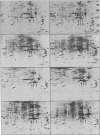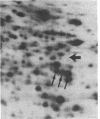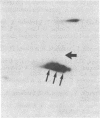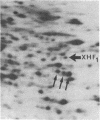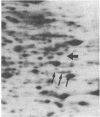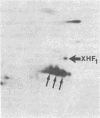Abstract
A set of proteins, which in normal fibroblasts were barely, if at all, detectable, were synthesized at an increased rate in fibroblasts from patients with Bloom syndrome (BS). The same set of proteins was induced in normal human fibroblasts by treatment with 12-O-tetradecanoylphorbol 13-acetate (TPA). In BS cells, TPA caused a further 2-fold increase in the rate of synthesis. Production of these proteins was inhibited by the addition of fluocinolone acetonide to the culture medium. One of the proteins (XHF1) present at high levels in BS fibroblasts and in TPA-treated cells was also induced by irradiation with ultraviolet light. This protein was secreted into the culture medium. Most other TPA-inducible proteins were cytoplasmic. Among other human mutants prone to chromosome aberrations we found one of three tested cases of Fanconi anemia and one case of ataxia-telangiectasia that showed increased spontaneous rates of synthesis of the TPA-inducible proteins. In these cases, however, the induction by TPA was like that seen in healthy fibroblasts.
Full text
PDF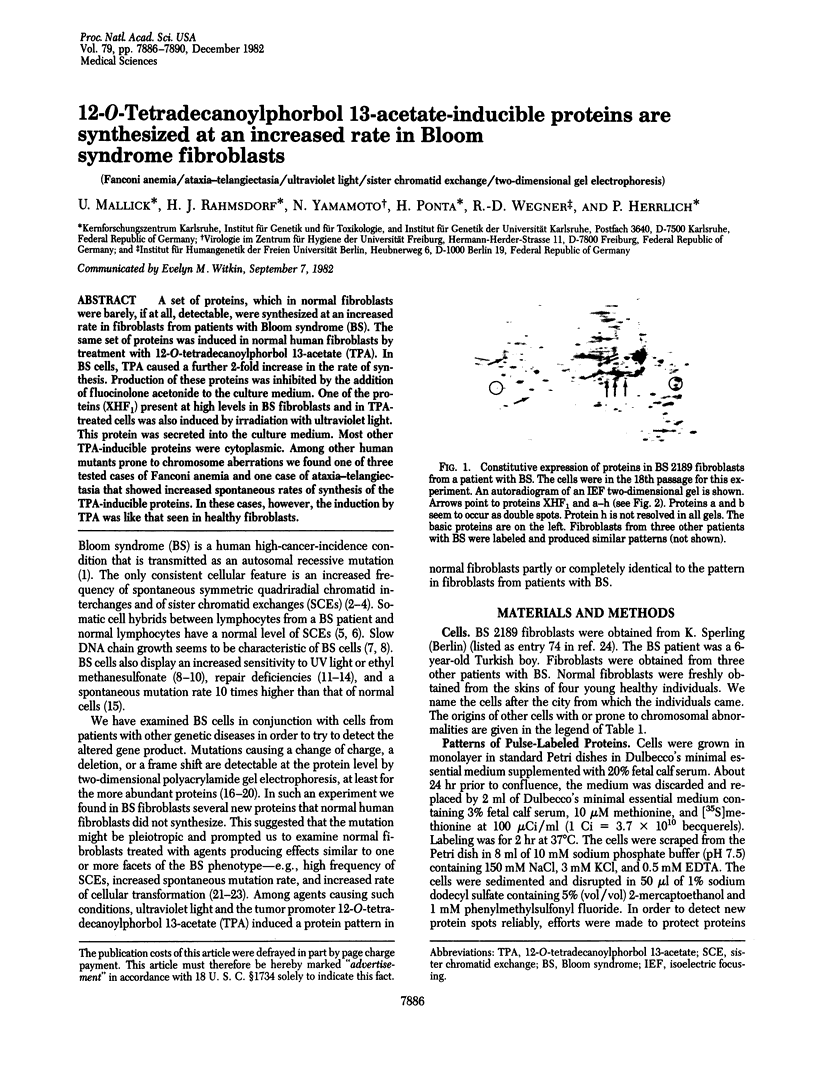
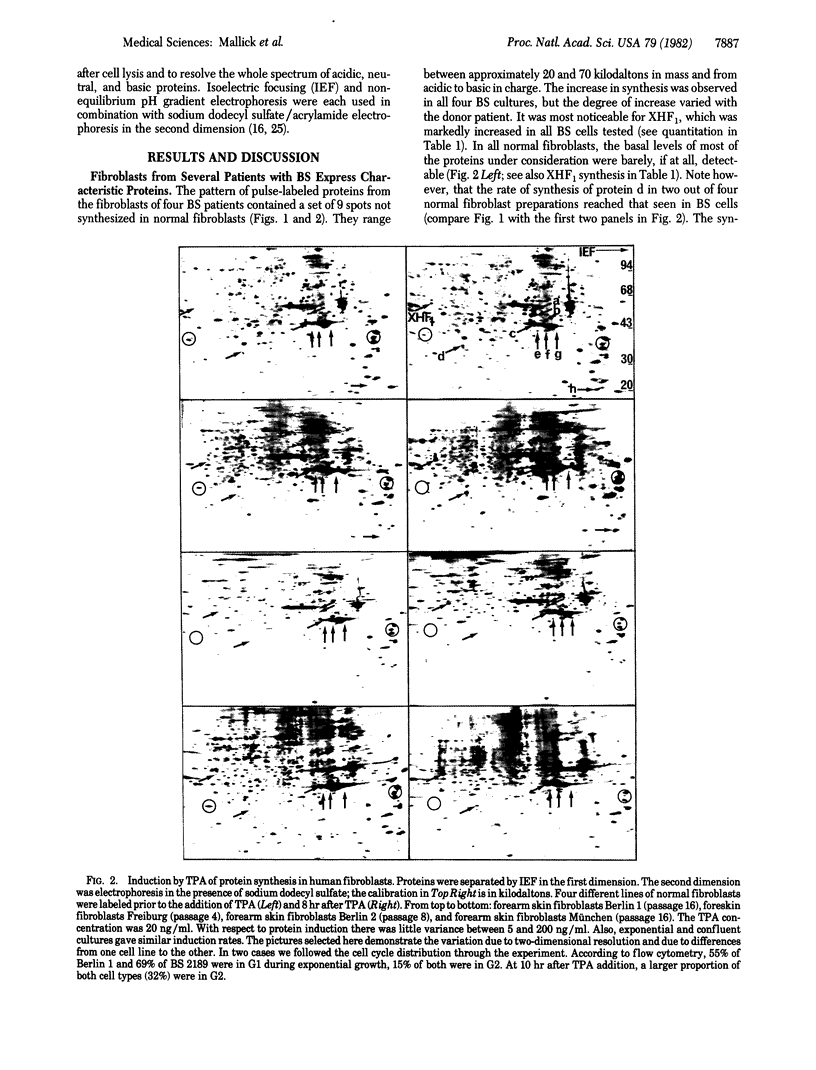

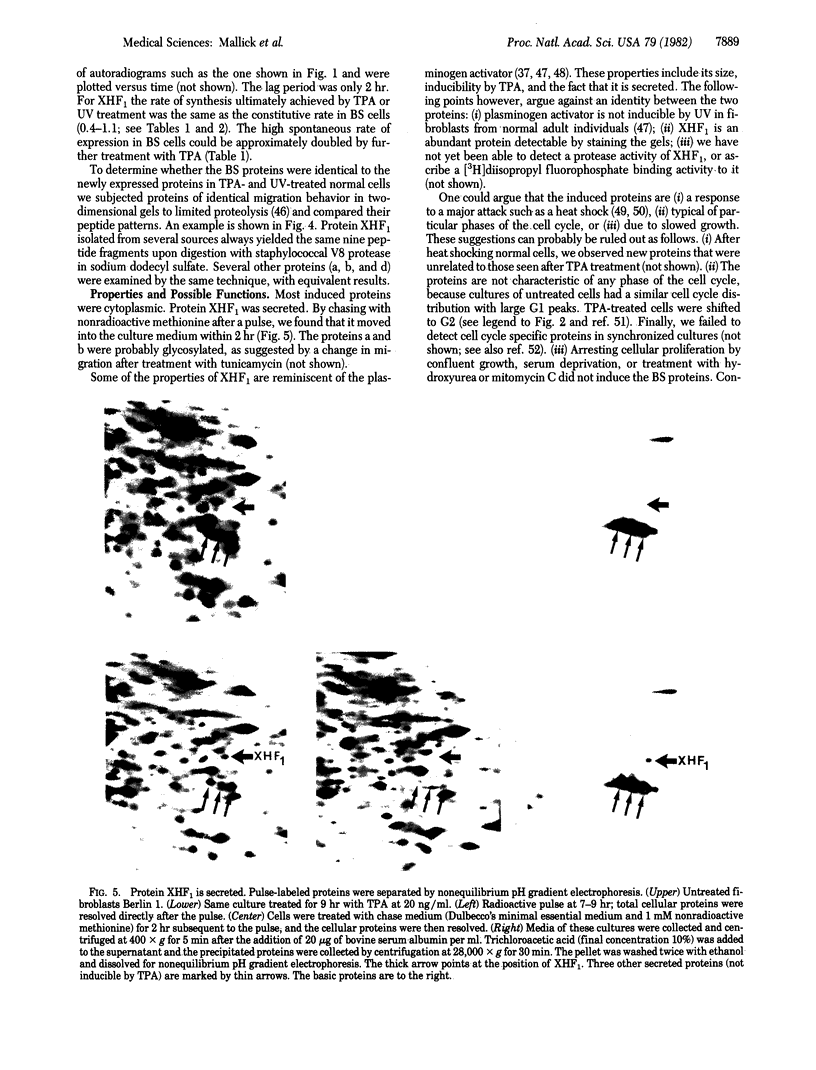
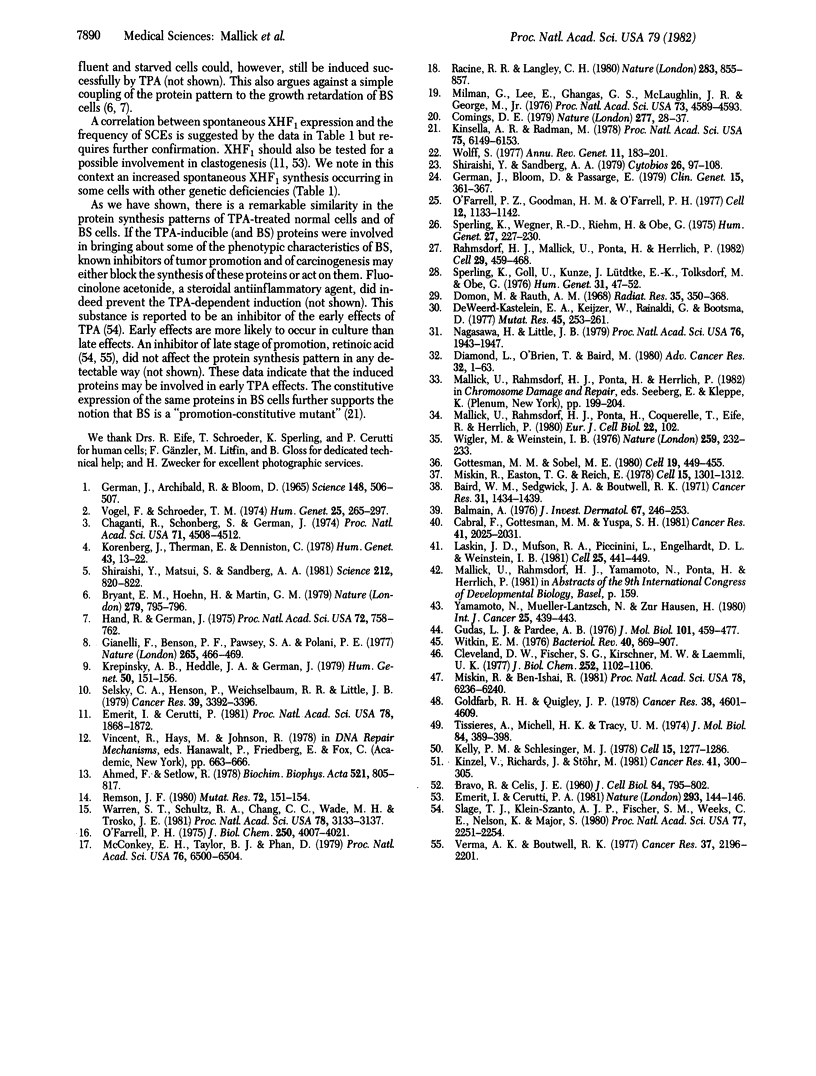
Images in this article
Selected References
These references are in PubMed. This may not be the complete list of references from this article.
- Ahmed F. E., Setlow R. B. Excision repair in ataxia telangiectasia, Fanconi's anemia, Cockayne syndrome, and Bloom's syndrome after treatment with ultraviolet radiation and N-acetoxy-2-acetylaminofluorene. Biochim Biophys Acta. 1978 Dec 21;521(2):805–817. doi: 10.1016/0005-2787(78)90319-2. [DOI] [PubMed] [Google Scholar]
- Baird W. M., Sedgwick J. A., Boutwell R. K. Effects of phorbol and four diesters of phorbol on the incorporation of tritiated precursors into DNA, RNA, and protein in mouse epidermis. Cancer Res. 1971 Oct;31(10):1434–1439. [PubMed] [Google Scholar]
- Balmain A. The synthesis of specific proteins in adult mouse epidermis during phases of proliferation and differentiation induced by the tumor promoter TPA, and in basal and differentiating layers of neonatal mouse epidermis. J Invest Dermatol. 1976 Aug;67(2):246–253. doi: 10.1111/1523-1747.ep12513451. [DOI] [PubMed] [Google Scholar]
- Bryant E. M., Hoehn H., Martin G. M. Normalisation of sister chromatid exchange frequencies in Bloom's syndrome by euploid cell hybridisation. Nature. 1979 Jun 28;279(5716):795–796. doi: 10.1038/279795a0. [DOI] [PubMed] [Google Scholar]
- Cabral F., Gottesman M. M., Yuspa S. H. Induction of specific protein synthesis by phorbol esters in mouse epidermal cell culture. Cancer Res. 1981 Jun;41(6):2025–2031. [PubMed] [Google Scholar]
- Chaganti R. S., Schonberg S., German J. A manyfold increase in sister chromatid exchanges in Bloom's syndrome lymphocytes. Proc Natl Acad Sci U S A. 1974 Nov;71(11):4508–4512. doi: 10.1073/pnas.71.11.4508. [DOI] [PMC free article] [PubMed] [Google Scholar]
- Cleveland D. W., Fischer S. G., Kirschner M. W., Laemmli U. K. Peptide mapping by limited proteolysis in sodium dodecyl sulfate and analysis by gel electrophoresis. J Biol Chem. 1977 Feb 10;252(3):1102–1106. [PubMed] [Google Scholar]
- Comings D. E. Pc 1 Duarte, a common polymorphism of a human brain protein, and its relationship to depressive disease and multiple sclerosis. Nature. 1979 Jan 4;277(5691):28–32. doi: 10.1038/277028a0. [DOI] [PubMed] [Google Scholar]
- De Weerd-Kastelein E. A., Keijzer W., Rainaldi G., Bootsma D. Induction of sister chromatid exchanges in xeroderma pigmentosum cells after exposure to ultraviolet light. Mutat Res. 1977 Nov;45(2):253–261. doi: 10.1016/0027-5107(77)90025-2. [DOI] [PubMed] [Google Scholar]
- Diamond L., O'Brien T. G., Baird W. M. Tumor promoters and the mechanism of tumor promotion. Adv Cancer Res. 1980;32:1–74. doi: 10.1016/s0065-230x(08)60360-7. [DOI] [PubMed] [Google Scholar]
- Emerit I., Cerutti P. A. Tumour promoter phorbol-12-myristate-13-acetate induces chromosomal damage via indirect action. Nature. 1981 Sep 10;293(5828):144–146. doi: 10.1038/293144a0. [DOI] [PubMed] [Google Scholar]
- Emerit I., Cerutti P. Clastogenic activity from Bloom syndrome fibroblast cultures. Proc Natl Acad Sci U S A. 1981 Mar;78(3):1868–1872. doi: 10.1073/pnas.78.3.1868. [DOI] [PMC free article] [PubMed] [Google Scholar]
- GERMAN J., ARCHIBALD R., BLOOM D. CHROMOSOMAL BREAKAGE IN A RARE AND PROBABLY GENETICALLY DETERMINED SYNDROME OF MAN. Science. 1965 Apr 23;148(3669):506–507. doi: 10.1126/science.148.3669.506. [DOI] [PubMed] [Google Scholar]
- German J., Bloom D., Passarge E. Bloom's syndrome. VII. Progress report for 1978. Clin Genet. 1979 Apr;15(4):361–367. doi: 10.1111/j.1399-0004.1979.tb01747.x. [DOI] [PubMed] [Google Scholar]
- Gianneli F., Benson P. F., Pawsey S. A., Polani P. E. Ultraviolet light sensitivity and delayed DNA-chain maturation in Bloom's syndrome fibroblasts. Nature. 1977 Feb 3;265(5593):466–469. doi: 10.1038/265466a0. [DOI] [PubMed] [Google Scholar]
- Goldfarb R. H., Quigley J. P. Synergistic effect of tumor virus transformation and tumor promoter treatment on the production of plasminogen activator by chick embryo fibroblasts. Cancer Res. 1978 Dec;38(12):4601–4609. [PubMed] [Google Scholar]
- Gottesman M. M., Sobel M. E. Tumor promoters and Kirsten sarcoma virus increase synthesis of a secreted glycoprotein by regulating levels of translatable mRNA. Cell. 1980 Feb;19(2):449–455. doi: 10.1016/0092-8674(80)90519-x. [DOI] [PubMed] [Google Scholar]
- Gudas L. J., Pardee A. B. DNA synthesis inhibition and the induction of protein X in Escherichia coli. J Mol Biol. 1976 Mar 15;101(4):459–477. doi: 10.1016/0022-2836(76)90240-0. [DOI] [PubMed] [Google Scholar]
- Hand R., German J. A retarded rate of DNA chain growth in Bloom's syndrome. Proc Natl Acad Sci U S A. 1975 Feb;72(2):758–762. doi: 10.1073/pnas.72.2.758. [DOI] [PMC free article] [PubMed] [Google Scholar]
- Kelley P. M., Schlesinger M. J. The effect of amino acid analogues and heat shock on gene expression in chicken embryo fibroblasts. Cell. 1978 Dec;15(4):1277–1286. doi: 10.1016/0092-8674(78)90053-3. [DOI] [PubMed] [Google Scholar]
- Kinsella A. R., Radman M. Tumor promoter induces sister chromatid exchanges: relevance to mechanisms of carcinogenesis. Proc Natl Acad Sci U S A. 1978 Dec;75(12):6149–6153. doi: 10.1073/pnas.75.12.6149. [DOI] [PMC free article] [PubMed] [Google Scholar]
- Kinzel V., Richards J., Stöhr M. Early effects of the tumor-promoting phorbol ester 12-O-tetradecanoylphorbol-13-acetate on the cell cycle traverse of asynchronous HeLa cells. Cancer Res. 1981 Jan;41(1):300–305. [PubMed] [Google Scholar]
- Korenberg J. R., Therman E., Denniston C. Hot spots and functional organization of human chromosomes. Hum Genet. 1978 Jul 12;43(1):13–22. doi: 10.1007/BF00396473. [DOI] [PubMed] [Google Scholar]
- Krepinsky A. B., Heddle J. A., German J. Sensitivity of Bloom's syndrome lymphocytes to ethyl methanesulfonate. Hum Genet. 1979;50(2):151–156. doi: 10.1007/BF00390236. [DOI] [PubMed] [Google Scholar]
- Laskin J. D., Mufson R. A., Piccinini L., Engelhardt D. L., Weinstein I. B. Effects of the tumor promoter 12-O-tetradecanoyl-phorbol-13-acetate on newly synthesized proteins in mouse epidermis. Cell. 1981 Aug;25(2):441–449. doi: 10.1016/0092-8674(81)90062-3. [DOI] [PubMed] [Google Scholar]
- McConkey E. H., Taylor B. J., Phan D. Human heterozygosity: a new estimate. Proc Natl Acad Sci U S A. 1979 Dec;76(12):6500–6504. doi: 10.1073/pnas.76.12.6500. [DOI] [PMC free article] [PubMed] [Google Scholar]
- Milman G., Lee E., Ghangas G. S., McLaughlin J. R., George M., Jr Analysis of HeLa cell hypoxanthine phosphoribosyltransferase mutants and revertants by two-dimensional polyacrylamide gel electrophoresis: evidence for silent gene activation. Proc Natl Acad Sci U S A. 1976 Dec;73(12):4589–4593. doi: 10.1073/pnas.73.12.4589. [DOI] [PMC free article] [PubMed] [Google Scholar]
- Miskin R., Ben-Ishai R. Induction of plasminogen activator by UV light in normal and xeroderma pigmentosum fibroblasts. Proc Natl Acad Sci U S A. 1981 Oct;78(10):6236–6240. doi: 10.1073/pnas.78.10.6236. [DOI] [PMC free article] [PubMed] [Google Scholar]
- Miskin R., Easton T. G., Reich E. Plasminogen activator in chick embryo muscle cells: induction of enzyme by RSV, PMA and retinoic acid. Cell. 1978 Dec;15(4):1301–1312. doi: 10.1016/0092-8674(78)90055-7. [DOI] [PubMed] [Google Scholar]
- Nagasawa H., Little J. B. Effect of tumor promoters, protease inhibitors, and repair processes on x-ray-induced sister chromatid exchanges in mouse cells. Proc Natl Acad Sci U S A. 1979 Apr;76(4):1943–1947. doi: 10.1073/pnas.76.4.1943. [DOI] [PMC free article] [PubMed] [Google Scholar]
- O'Farrell P. H. High resolution two-dimensional electrophoresis of proteins. J Biol Chem. 1975 May 25;250(10):4007–4021. [PMC free article] [PubMed] [Google Scholar]
- O'Farrell P. Z., Goodman H. M., O'Farrell P. H. High resolution two-dimensional electrophoresis of basic as well as acidic proteins. Cell. 1977 Dec;12(4):1133–1141. doi: 10.1016/0092-8674(77)90176-3. [DOI] [PubMed] [Google Scholar]
- Racine R. R., Langley C. H. Genetic heterozygosity in a natural population of Mus musculus assessed using two-dimensional electrophoresis. Nature. 1980 Feb 28;283(5750):855–857. doi: 10.1038/283855a0. [DOI] [PubMed] [Google Scholar]
- Rahmsdorf H. J., Mallick U., Ponta H., Herrlich P. A B-lymphocyte-specific high-turnover protein: constitutive expression in resting B cells and induction of synthesis in proliferating cells. Cell. 1982 Jun;29(2):459–468. doi: 10.1016/0092-8674(82)90162-3. [DOI] [PubMed] [Google Scholar]
- Remsen J. F. Repair of damage by N-acetoxy-2-acetylaminofluorene in Bloom's syndrome. Mutat Res. 1980 Aug;72(1):151–154. doi: 10.1016/0027-5107(80)90231-6. [DOI] [PubMed] [Google Scholar]
- Selsky C. A., Henson P., Weichselbaum R. R., Little J. B. Defective reactivation of ultraviolet light-irradiated herpesvirus by a Bloom's syndrome fibroblast strain. Cancer Res. 1979 Sep;39(9):3392–3396. [PubMed] [Google Scholar]
- Shiraishi Y., Matsui S., Sandberg A. A. Normalization by cell fusion of sister chromatid exchange in Bloom syndrome lymphocytes. Science. 1981 May 15;212(4496):820–822. doi: 10.1126/science.7221565. [DOI] [PubMed] [Google Scholar]
- Shiraishi Y., Sandberg A. A. Effects of chemicals on the frequency of sister chromatid exchanges and chromosome aberrations in normal and Bloom's syndrome lymphocytes. Cytobios. 1979;26(102):91–108. [PubMed] [Google Scholar]
- Slaga T. J., Klein-Szanto A. J., Fischer S. M., Weeks C. E., Nelson K., Major S. Studies on mechanism of action of anti-tumor-promoting agents: their specificity in two-stage promotion. Proc Natl Acad Sci U S A. 1980 Apr;77(4):2251–2254. doi: 10.1073/pnas.77.4.2251. [DOI] [PMC free article] [PubMed] [Google Scholar]
- Sperling K., Goll U., Kunze J., Lüdtke E. K., Tolksdorf M., Obe G. Cytogenetic investigations in a new case of Bloom's syndrome. Hum Genet. 1976 Jan 28;31(1):47–52. doi: 10.1007/BF00270398. [DOI] [PubMed] [Google Scholar]
- Sperling K., Wegner R. D., Riehm H., Obe G. Frequency and distribution of sister-chromatid exchanges in a case of Fanconi's anemia. Humangenetik. 1975;27(3):227–230. doi: 10.1007/BF00278349. [DOI] [PubMed] [Google Scholar]
- Tissières A., Mitchell H. K., Tracy U. M. Protein synthesis in salivary glands of Drosophila melanogaster: relation to chromosome puffs. J Mol Biol. 1974 Apr 15;84(3):389–398. doi: 10.1016/0022-2836(74)90447-1. [DOI] [PubMed] [Google Scholar]
- Verma A. K., Boutwell R. K. Vitamin A acid (retinoic acid), a potent inhibitor of 12-O-tetradecanoyl-phorbol-13-acetate-induced ornithine decarboxylase activity in mouse epidermis. Cancer Res. 1977 Jul;37(7 Pt 1):2196–2201. [PubMed] [Google Scholar]
- Vogel F., Schroeder T. M. The internal order of the interphase nucleus. Humangenetik. 1974;25(4):265–297. doi: 10.1007/BF00336904. [DOI] [PubMed] [Google Scholar]
- Warren S. T., Schultz R. A., Chang C. C., Wade M. H., Trosko J. E. Elevated spontaneous mutation rate in Bloom syndrome fibroblasts. Proc Natl Acad Sci U S A. 1981 May;78(5):3133–3137. doi: 10.1073/pnas.78.5.3133. [DOI] [PMC free article] [PubMed] [Google Scholar]
- Wigler M., Weinstein I. B. Tumour promotor induces plasminogen activator. Nature. 1976 Jan 22;259(5540):232–233. doi: 10.1038/259232a0. [DOI] [PubMed] [Google Scholar]
- Witkin E. M. Ultraviolet mutagenesis and inducible DNA repair in Escherichia coli. Bacteriol Rev. 1976 Dec;40(4):869–907. doi: 10.1128/br.40.4.869-907.1976. [DOI] [PMC free article] [PubMed] [Google Scholar]
- Wolff S. Sister chromatid exchange. Annu Rev Genet. 1977;11:183–201. doi: 10.1146/annurev.ge.11.120177.001151. [DOI] [PubMed] [Google Scholar]
- Yamamoto N., Mueller-Lantzsch N., zur Hausen H. Differential inhibition of Epstein-Barr virus induction by the amino acid analogue, L-canavanine. Int J Cancer. 1980 Apr 15;25(4):439–443. doi: 10.1002/ijc.2910250403. [DOI] [PubMed] [Google Scholar]




